While a relatively snow-free winter isn’t exactly keeping New Englanders indoors this year, a new batch of exhibitions opening at museums across the region certainly helps sweeten the deal to get out and experience art. The Boston Art Review editors have selected thirteen not-to-be-missed exhibitions, all within an hour of the city, that provide a refreshing mix of perspectives, from the local and the historical to the fanciful, the personal, and the political. Read on to learn about solo exhibitions of work by Sneha Shrestha (aka IMAGINE) at the Cantor Art Gallery, Ria Brodell at the Fitchburg Art Museum, Lorraine O’Grady at the Davis Museum, and many others. Exhibitions are ordered by opening date.
Online • Feb 06, 2024
Thirteen Exhibitions to Catch This Winter
Within an hour of the city, these are not-to-be-missed shows offering a refreshing mix of perspectives at museums and university art galleries.
Feature by BAR Editorial
Installation view, "Sneha Shrestha: Ritual and Devotion," The Iris and B. Gerald Cantor Art Gallery at College of the Holy Cross, Worcester, MA. On view through April 5, 2024.
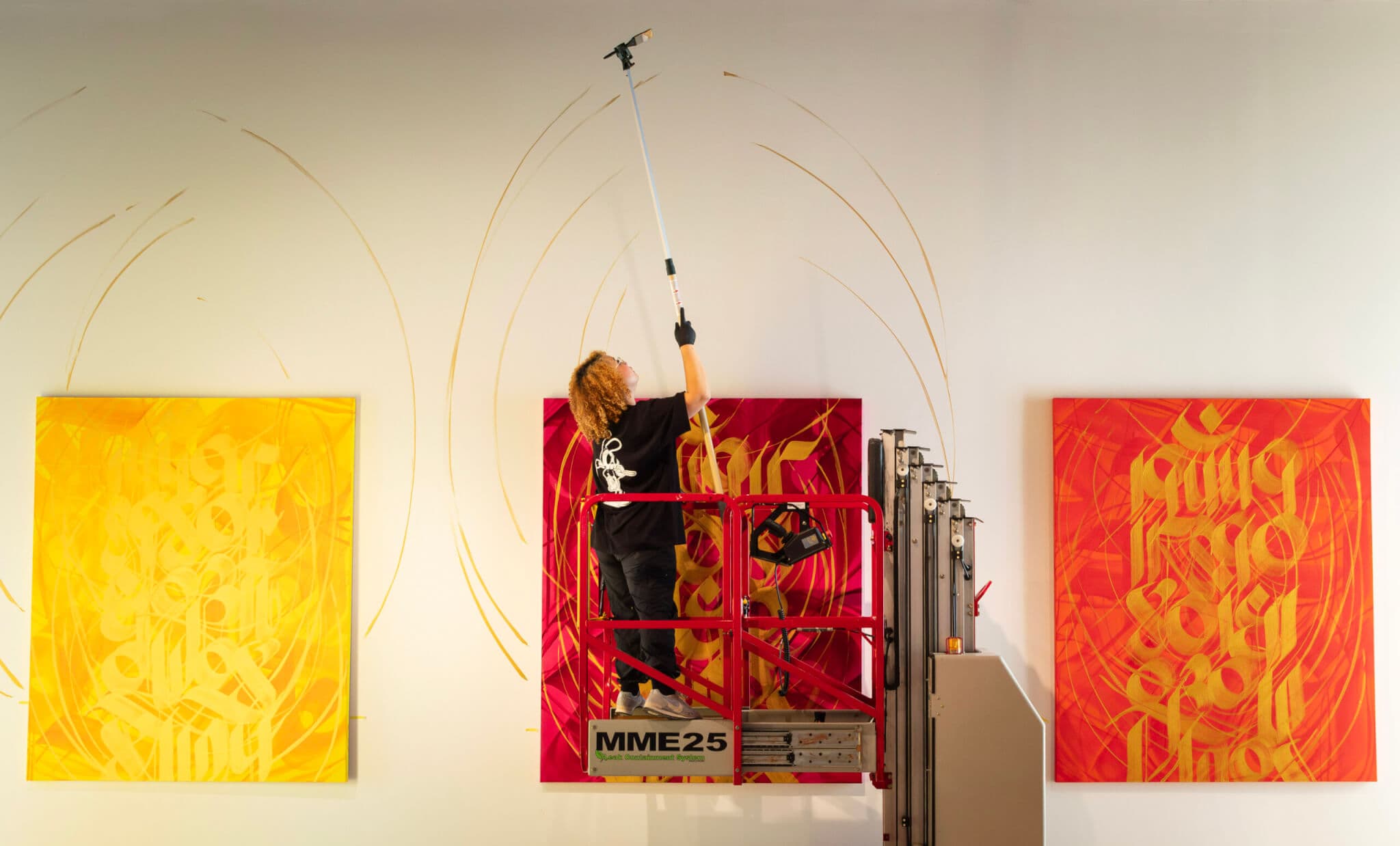
Installation view, "Sneha Shrestha: Ritual and Devotion," The Iris and B. Gerald Cantor Art Gallery at College of the Holy Cross, Worcester, MA. On view through April 5, 2024.
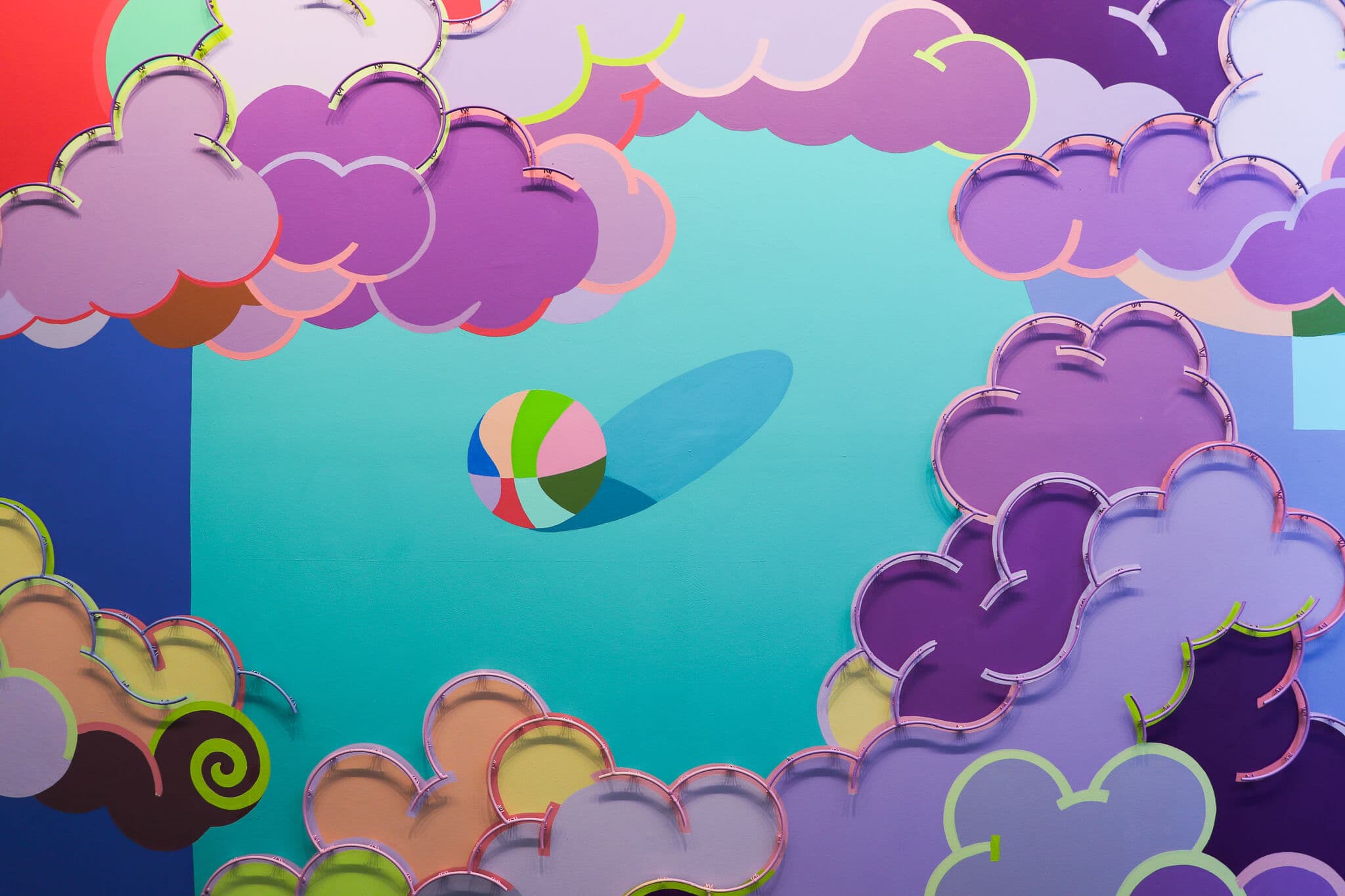
Installation view, “Maria Molteni: Soft Score,” Fuller Craft Museum, Brockton, MA. On view through January 5, 2025. Photo by Caitlin Burton.
“Maria Molteni: Soft Score,” January 13, 2024–January 5, 2025
Fuller Craft Museum
455 Oak St., Brockton
I was ecstatic to see Maria Molteni’s massive Gateway to Infinity (An Anti-monument) ground mural open on the Greenway this summer. Directly in dialogue with their socially engaged public art practice, Molteni’s “Soft Score” is a new, site-specific exhibition at the Fuller Craft Museum that explores the confluence of art and athletics (particularly basketball). While these may seem like two different worlds, Molteni reveals the overlaps in how we engage with art and athletics through our minds, bodies, and spirits, drawing on practices of play, systems, and ritual. From a large-scale wall mural made from welded basketball hoops to performance and sculptural works, “Soft Score” invites playful engagement, blurring the divide between spectator and participant with vivid color. —Gina Lindner
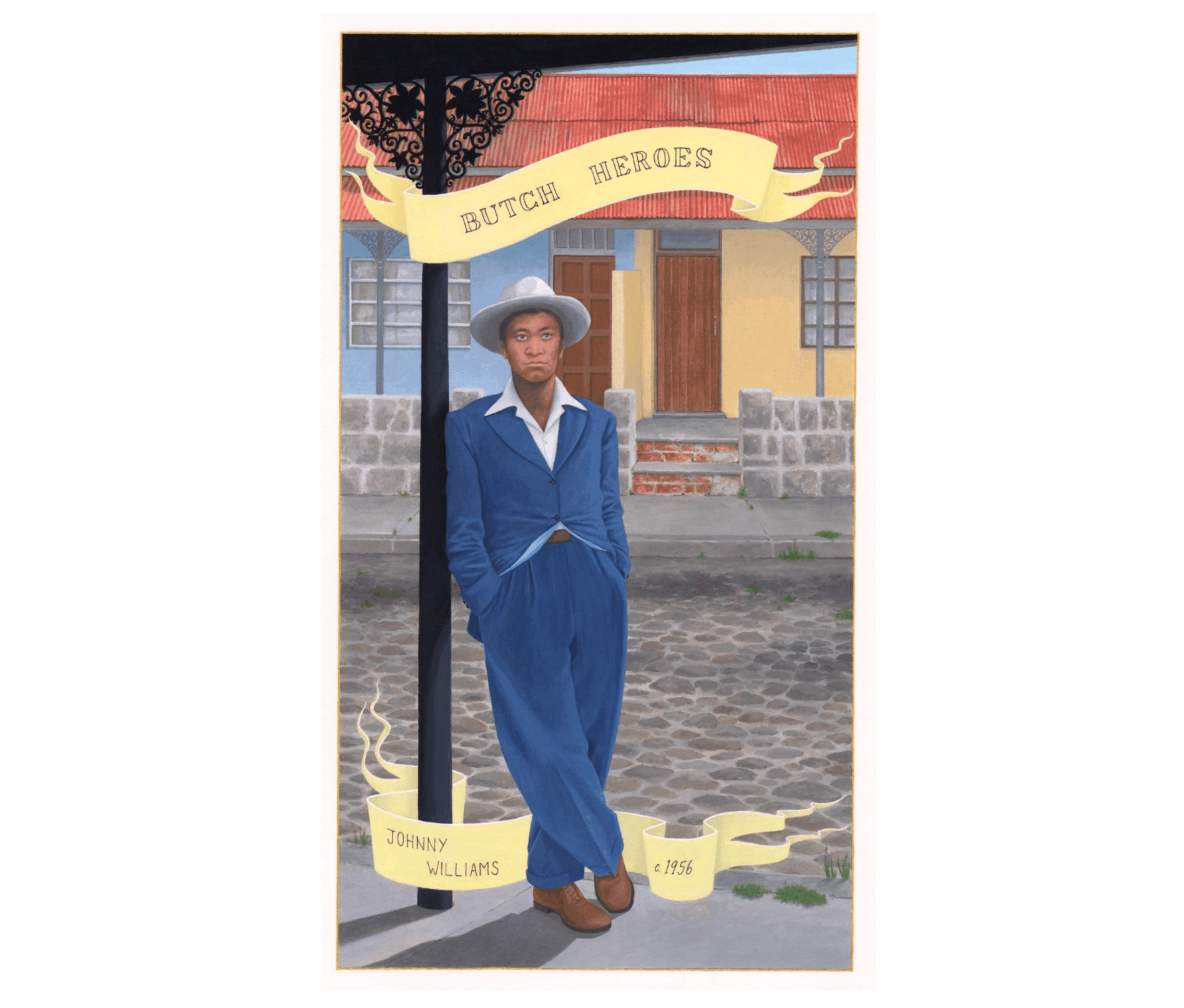
Ria Brodell, Johnny Williams c. 1956 South Africa, 2022. Gouache on paper. 11″ x 7″. Courtesy of the artist. Photo by Ria Brodell.
“Ria Brodell: Butch Heroes,” January 20–June 2, 2024
Fitchburg Art Museum
185 Elm St., Fitchburg
In the Catholic tradition, holy cards typically depict a luminous illustration of a saint with a prayer on the back, offering a pocket-sized point of engagement with faith. For Ria Brodell, a nonbinary trans artist and self-proclaimed former Catholic, the cards are backdrop for reclaiming and reimagining figures from throughout history who were assigned female at birth but who pushed at heterosexual norms associated with their assigned gender. Brodell calls these figures “Butch Heroes.” The thoughtfully researched and meticulously painted portraits have been the focal point of Brodell’s work since 2010. The portraits both celebrate and validate queer histories while subverting the notion of “holiness” and offering a space to consider the abuses that LGBTQIA+ individuals have been subjected to by the Catholic church. At the Fitchburg Art Museum, Brodell presents seventeen works from the Butch Heroes series, many of which will be on view for the first time and will be included in the second edition of the artist’s forthcoming book. —Jameson Johnson
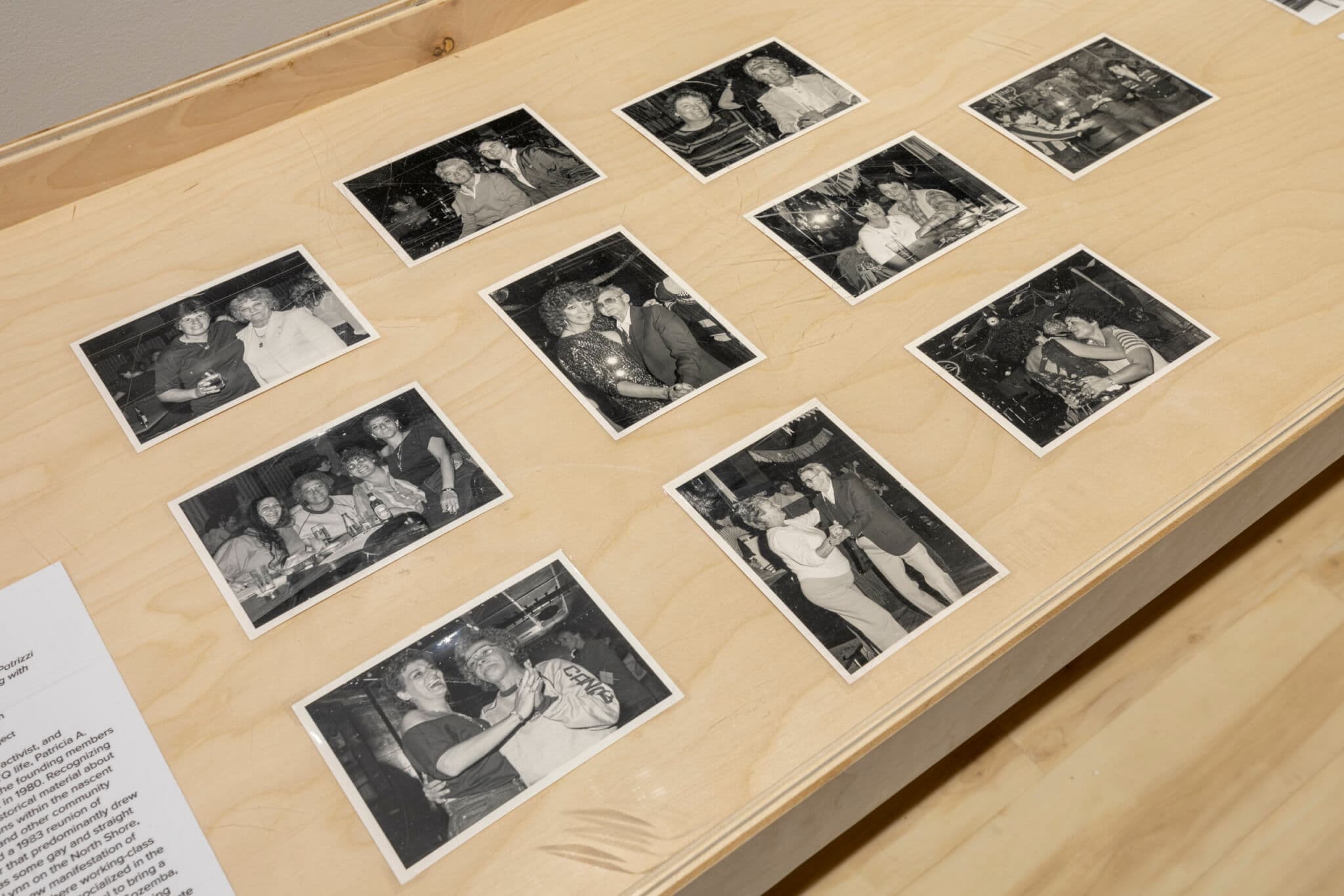
“As the World Burns: Queer Photography and Nightlife in Boston,” installation view, Tufts University Art Galleries, 2024. Photo by Mel Taing.
“As the World Burns: Queer Photography and Nightlife in Boston,” January 24–April 21, 2024
SMFA at Tufts
230 Fenway, Boston
A companion to the survey “Christian Walker: The Profane and the Poignant,” on view concurrently at the SMFA, this show is well worth checking out in its own right. “As the World Burns” focuses on photos from the 1970s and early ’80s, a dynamic era for both the city’s photography scene and local LGBTQ activism, culture, and nightlife. Curators Jackson Davidow and Laurel V. McLaughlin draw on three categories of images that intersect yet are rarely shown together, creating a conversation among photographers working in a fine art context (including Walker and Boston School names like Gail Thacker and Shellburne Thurber), photojournalists contributing to outlets such as Gay Community News, and other community members capturing moments from their lives on film. Providing glimpses of bygone nightspots—from downtown discotheque Club Max to longtime Lynn lesbian bar Fran’s Place—the show documents the making of identity and community in a time of change and offers an ode to the power and pleasure of IRL connection. —Jacqueline Houton
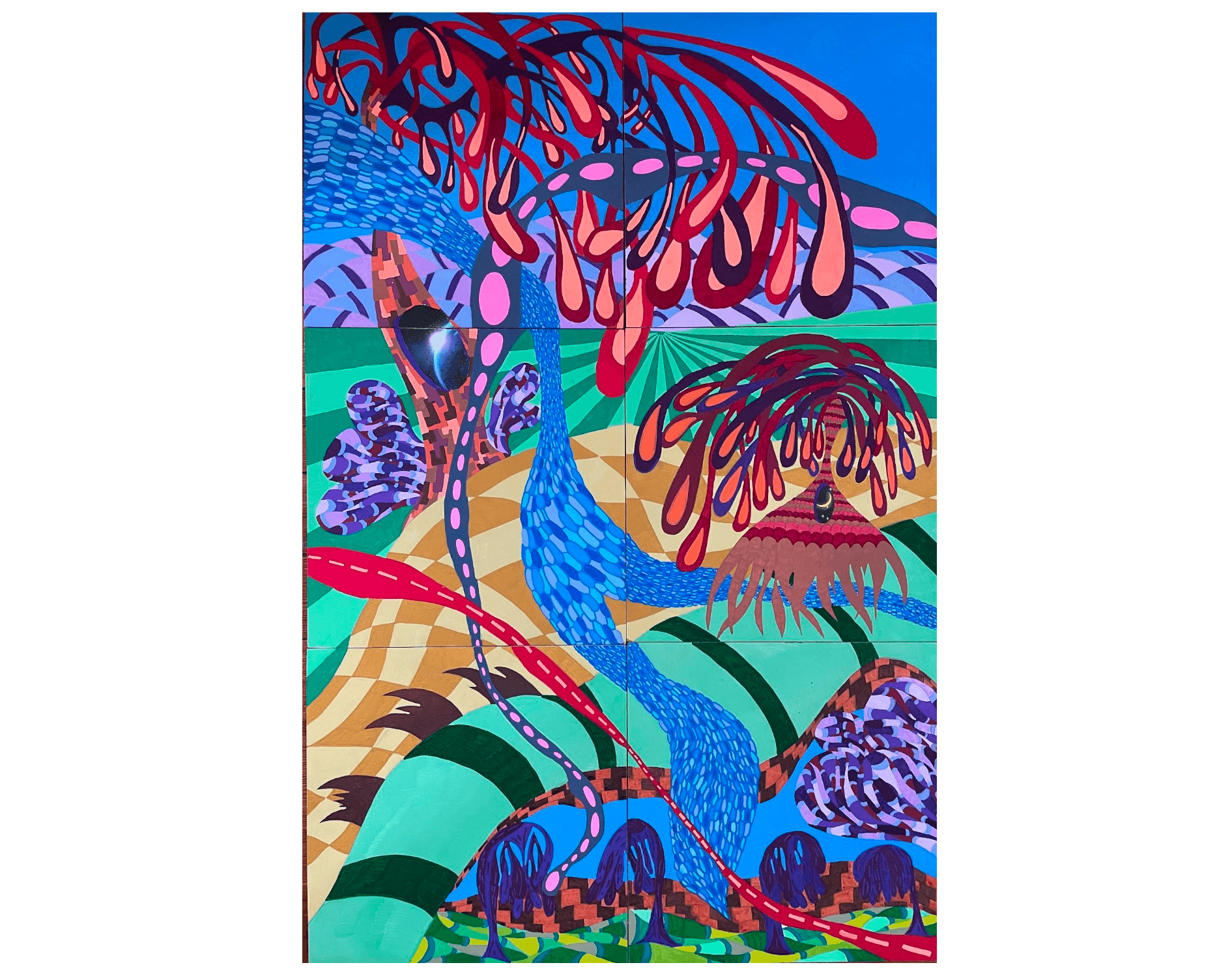
Karmimadeebora McMillan, New Dawn, 2024. Acrylic and collage on wood panel, 24×36.
“Karmimadeebora McMillan: Wandering stars…for whom it is reserved…the blackness…the darkness…forever,” January 30–March 6, 2024
Montserrat Gallery, Montserrat College of Art
23 Essex St., Beverly
At her first major solo exhibition in New England, North Carolina-born and Cambridge-based artist Karmimadeebora McMillan presents a multimedia installation of animation, painting, and sound. Pulling from her childhood in the South, McMillan takes historical objects that depict Blackness and Black bodies with racist intent and bends them into freer, more possible realms, imbued with her own feeling and interpretation of the archive. Among other characters, a vintage doll-girl is a central figure in and of the speculative and many-hued landscape paintings McMillan creates. McMillan has reimagined this Black caricature as “Ms. Merri Mack,” deriving her name from a nursery rhyme that enslaved children may have sung on southern plantations about a Union ship during the civil war. In this show, Ms. Merri Mack and McMillan herself become a vessel, and a universe, of revised memory and futurity—always moving toward the threshold of other worlds. —Niara Simone Hightower

Installation view, “Sneha Shrestha: Ritual and Devotion,” The Iris and B. Gerald Cantor Art Gallery at College of the Holy Cross, Worcester, MA. On view through April 5, 2024.
“Sneha Shrestha: Ritual and Devotion,”February 1–April 5, 2024
The Iris and B. Gerald Cantor Art Gallery at College of the Holy Cross
1 College St., Worcester
The colorful paint strokes in Nepali artist Sneha “Imagine” Shrestha’s new exhibit “Ritual and Devotion” reach deep into the past while elevating her familial present. Shrestha is known for her calligraphic graffiti work emblazoning the Nepali alphabet on buildings in various cities, from Boston to Istanbul. In “Ritual and Devotion,” her first major solo exhibition at the Cantor Art Gallery, Shrestha stays true to her ancient leanings centered on ritual, heritage, memory, and identity. Through gorgeous, bold paintings saturated with azure, green, orange, red, and yellow, the artist ponders acts such as filling out immigration forms, treasuring family photographs, and creating new work as ritualistic and devotional. —Jacquinn Sinclair
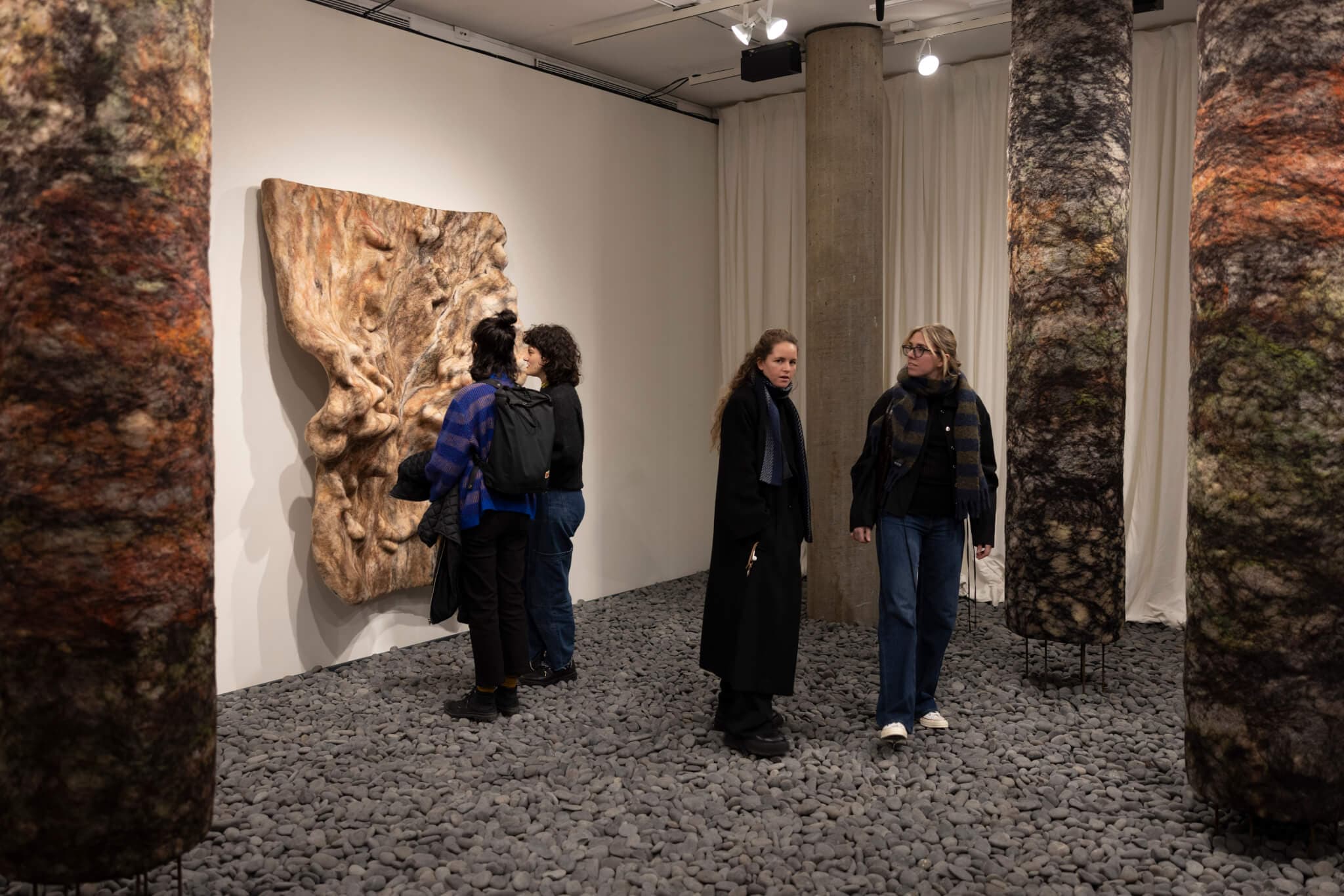
Installation view, “Jacqueline Kiyomi Gork: Poems of Electronic Air,” Carpenter Center for the Visual Arts, Cambridge, MA. On view through April 7, 2024. Photo by Susan Young.
“Jacqueline Kiyomi Gork: Poems of Electronic Air,” February 2–April 7, 2024
Carpenter Center for the Visual Arts, Harvard University
24 Quincy St., Cambridge
Sound art can be hard to come by, and Jacqueline Kiyomi Gork’s “Poems of Electronic Air” is the sonic art experience I’ve been waiting for. The highlight of the exhibition is a site-specific, interactive installation that engulfs visitors in an immersive echo chamber: every footstep across a rocky floor triggers a series of sonic feedback loops, which are absorbed to varying effects by the felted sculptures and columns in the gallery. Moving through the space, visitors become part of a live, sonic choreography that creates a unique listening experience in every corner. Other works consider the relationships between the body and architecture, such as a series of inflatable sculptures in the outdoor CCVA “pit” that rise and fall against a reverberating soundscape of blowers and music. Kyomi Gork’s show is an unusual opportunity for deep listening and attunement to our environment, making for a visceral, embodied experience like no other. —Gina Lindner
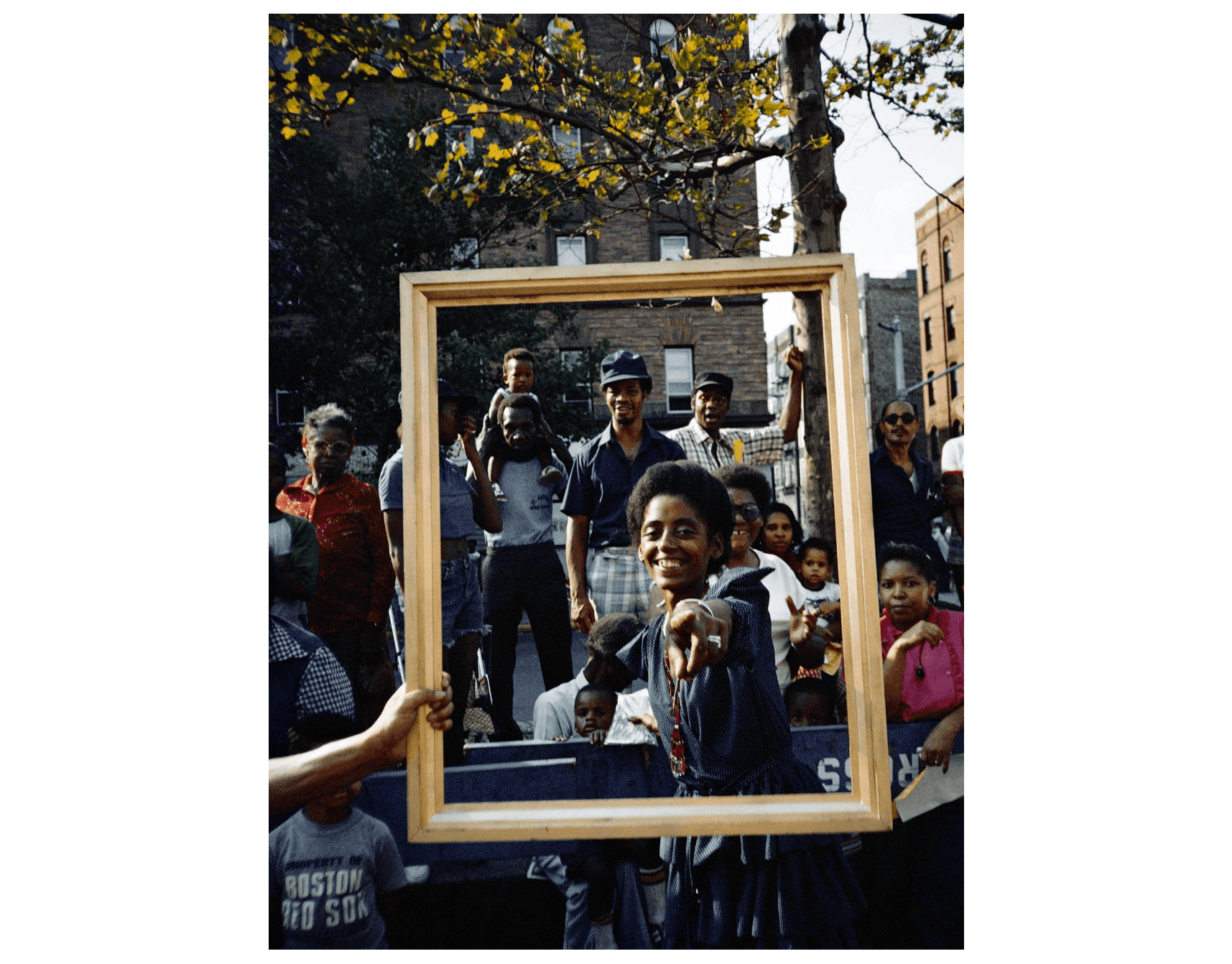
Lorraine O’Grady, Art Is. . . (Girl Pointing), 1983/2009. Chromogenic photograph in forty parts, 20 × 16 in. Edition of eight plus one artist’s proof. © Lorraine O’Grady/Artists Rights Society (ARS), New York.
“Lorraine O’Grady: Both/And,” February 8–June 2, 2024
Davis Museum at Wellesley College
106 Central St., Wellesley
Wellesley College is celebrating trailblazing alumna Lorraine O’Grady in her first major career survey. The conceptual artist, who grew up in Roxbury, has never been afraid to reinvent herself—she began her art career in her forties after working as an intelligence analyst for the US State Department, a professional translator, and a rock critic. Throughout her career, O’Grady has embraced the use of the diptych to play with the idea of contradictions and interrogate power dynamics. She’s also known for her iconic performance pieces in the early 1980s featuring her “Mlle. Bourgeoise Noire” persona; donning a dress made of thrifted white gloves and carrying a cat o’ nine tails, she would crash crowded openings to critique the segregation of the New York art scene. Throughout the exhibition’s run, the Davis Museum will pay tribute to “Mlle. Bourgeoise Noire” by “taking the white gloves off” through a series of performances led by six multidisciplinary artists. —Karolina Hać
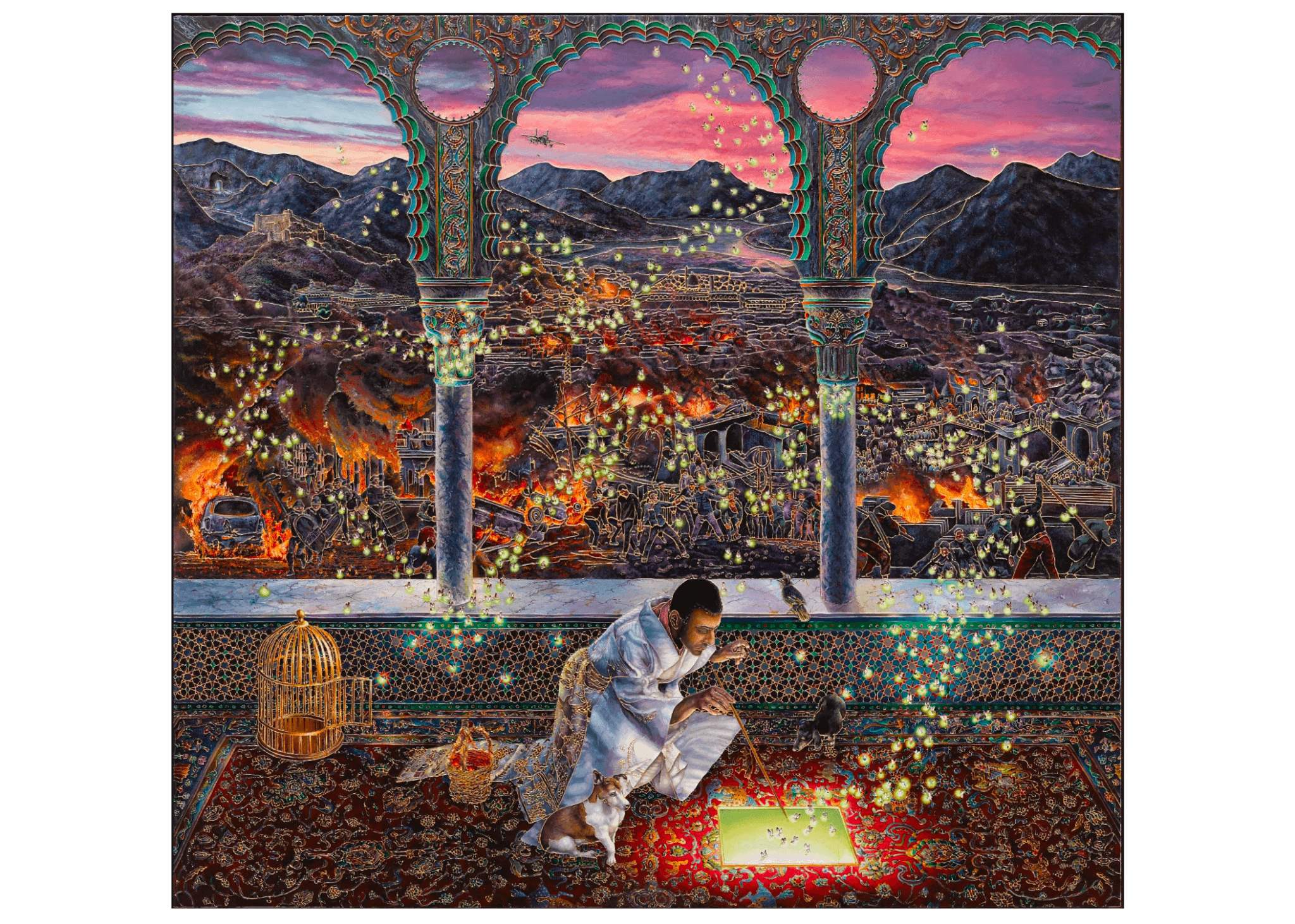
Raqib Shaw, Ode to the Country without a Post Office, 2019–20. © Raqib Shaw. Private Collection. Photo © (White Cube) Theo Christelis.
“Raqib Shaw: Ballads of East and West,” February 15–May 12, 2024
Isabella Stewart Gardner Museum
25 Evans Way, Boston
Raqib Shaw’s paintings are so sensuously intricate that you can’t help but get lost in them. Shaw grew up amid the natural beauty of the Kashmir region in the Indian city of Srinagar, and his work painstakingly balances the tension of experiencing what he calls a “Kashmiri paradise” irreparably damaged by political upheaval. The London-based artist frequently explores the intersections of East and West in his practice by setting personal narratives against the backdrop of influences from mythology, art history, poetry, and natural history. Shaw creates Bosch-like landscapes with a medley of paints applied with a porcupine quill, which is seemingly how he maintains an incredible amount of precision. First exhibited at the Frist Museum in Nashville, “Raqib Shaw: Ballads of East and West” will take over the Gardner with a newly commissioned work on its facade and paintings exhibited in the Fenway and Hostetter galleries. —Karolina Hać
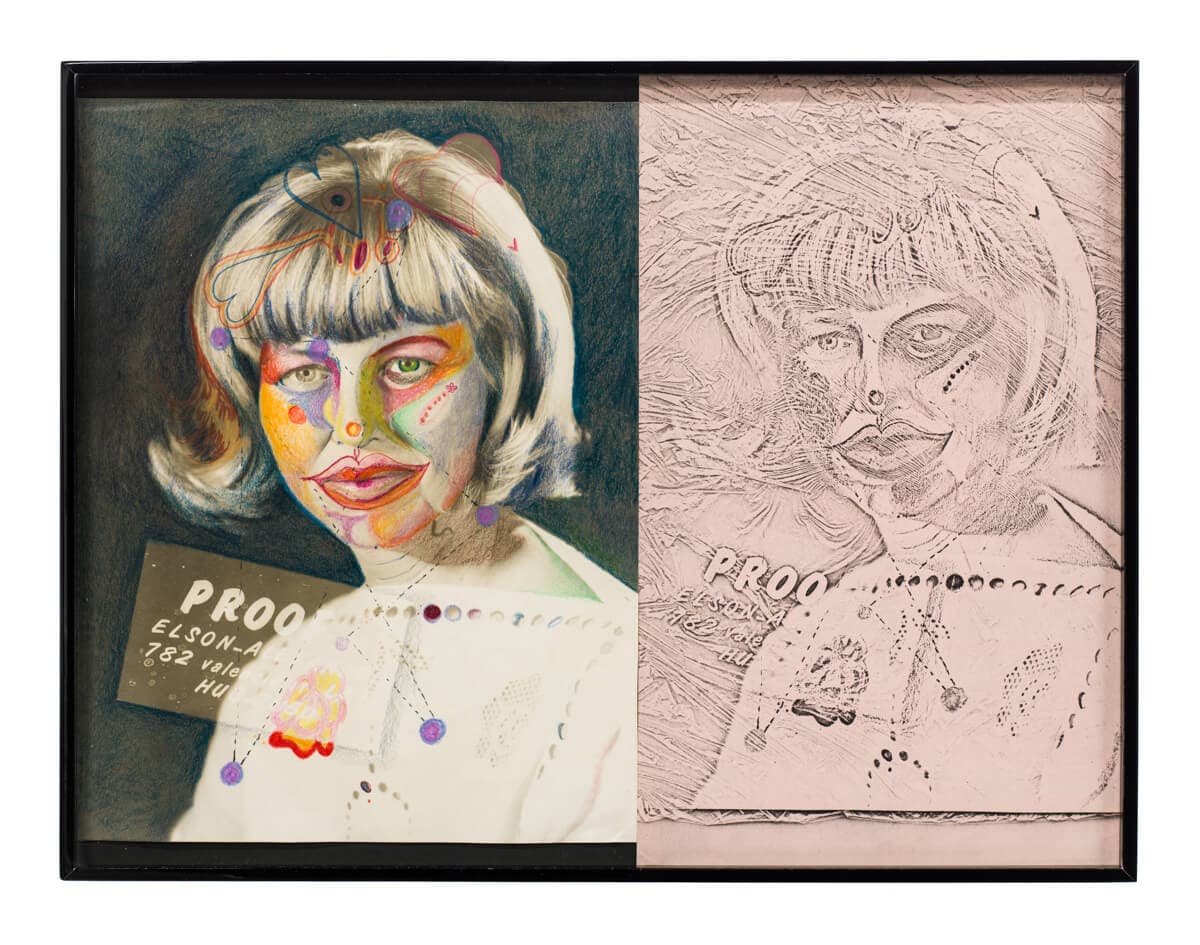
Barbara T. Smith, Proof, 1966–67. Xerox and drawing. 14 x 19 inches. Courtesy the artist and The Box, Los Angeles.
“Barbara T. Smith: Proof,” February 22–June 2, 2024
David Winton Bell Gallery, Brown University
64 College St., Providence
When Barbara T. Smith was twenty-seven, she was a disillusioned 1950s housewife with three kids in a cookie-cutter marriage. After completing psychoanalysis, an experience she was, according to her memoir, “blown away” by, she entered a new understanding of what artmaking could be. “No longer were we part of the long history of framed paintings on the wall,” she wrote. “Art could be anyplace by any means out here in the real world.” Opening on February 22 at Brown University’s David Winton Bell Gallery, “Barbara T. Smith: Proof” chronicles the artist’s fifty-plus year exploration of that hard-won recognition, showcasing her early Xerox-machine works, as well as paintings and documentation from her pioneering performances and installations. Driven to better understand her body and its social positioning following multiple bouts of postpartum depression and a devastating custody battle, Smith has created work that challenges the way we approach the most basic human experiences: sexuality, spirituality, aging, and death. This show provides the evidence of a life lived exploding boundaries, offering up the material to “blow away” a new generation. —Jessica Shearer
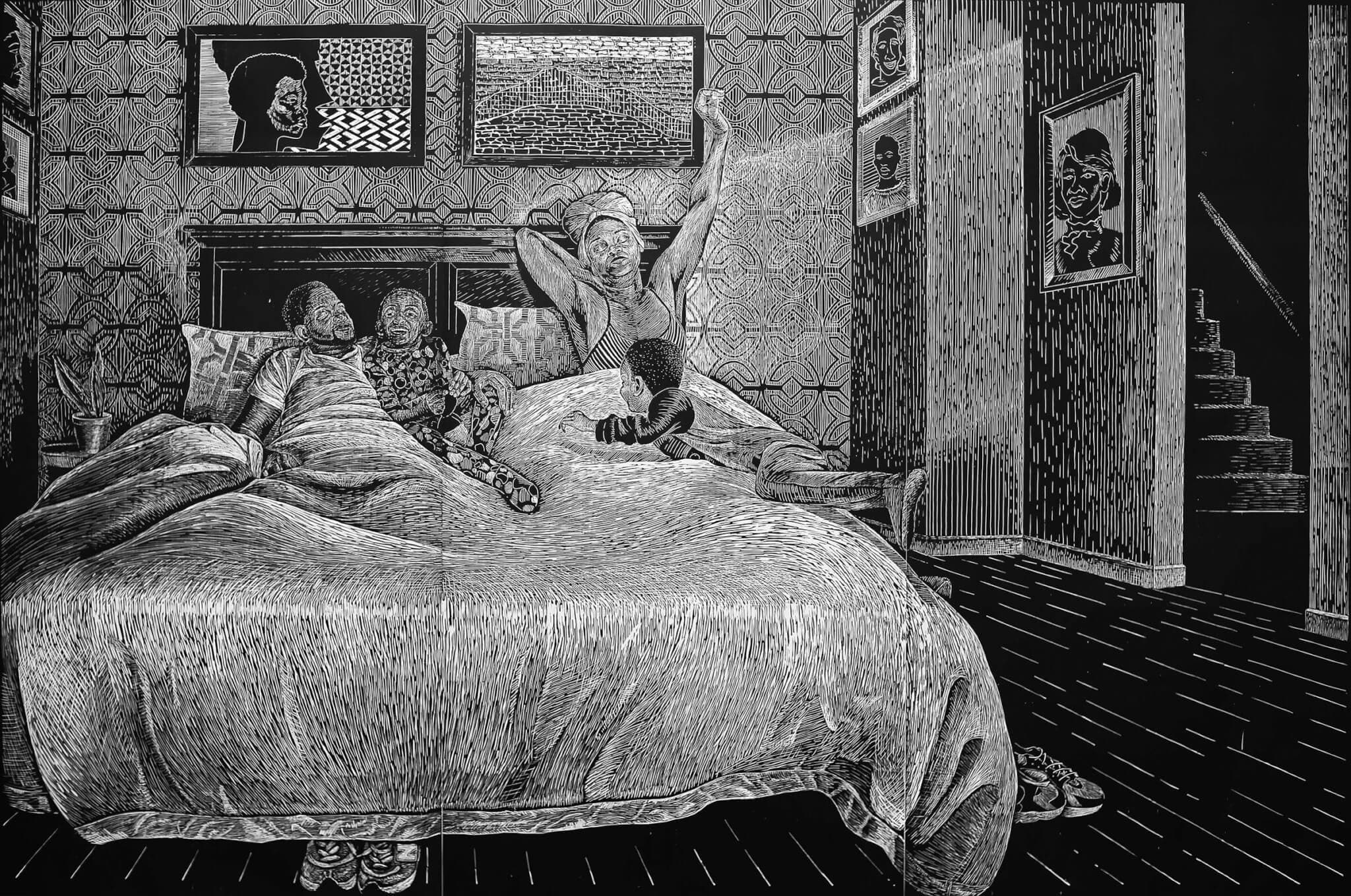
LaToya M. Hobbs, Scene 1: Morning, from Carving Out Time, 2020–21. Woodcut on cotton paper. 98 13/16 × 144 in. Harvard Art Museums/Fogg Museum, Margaret Fisher Fund, 2022.224.1 © LaToya M. Hobbs. Photo by Ariston Jacks. Courtesy of the artist.
“LaToya M. Hobbs: It’s Time,” March 1–July 21, 2024
Special Exhibitions Gallery, Harvard Art Museums
32 Quincy St., Cambridge
The phrase “It’s time” feels like the start of a prompt (“It’s time to get up,” “It’s time for bed”) uttered by a caregiver who may hold multiple roles—mother, lover, daughter, sister, auntie, friend—as she carries the ones she loves (herself included) through their days. At the start of Women’s History Month, Baltimore-based artist and Black Women of Print founding member LaToya M. Hobbs debuts the so-titled first complete exhibition of her Carving Out Time series at Harvard Art Museums. In a gallery filled with seating, rugs, and pillows, three walls house five consecutive eight-by-twelve-foot woodcuts, absorbing viewers into Hobbs’s full life, first at home with her family and subsequently alone in her studio. They’re joined on a fourth wall by six preliminary drawings and a video, shown here for the first time, that documents Hobbs’s labor over the prints and features interlocutors like Hobbs’s two young sons and the artist collaborative BIG INK. In Colossal magazine last year, Hobbs described the “act of carving and its removal of material” in her prints as a way of “reveal[ing] the real version of oneself.” “Carving time,” then, carefully and rhythmically names the way Black women design their worlds each day. Join Hobbs on March 1 for an artist talk and visit the museum website for a full list of exhibition-related programs. —Niara Simone Hightower
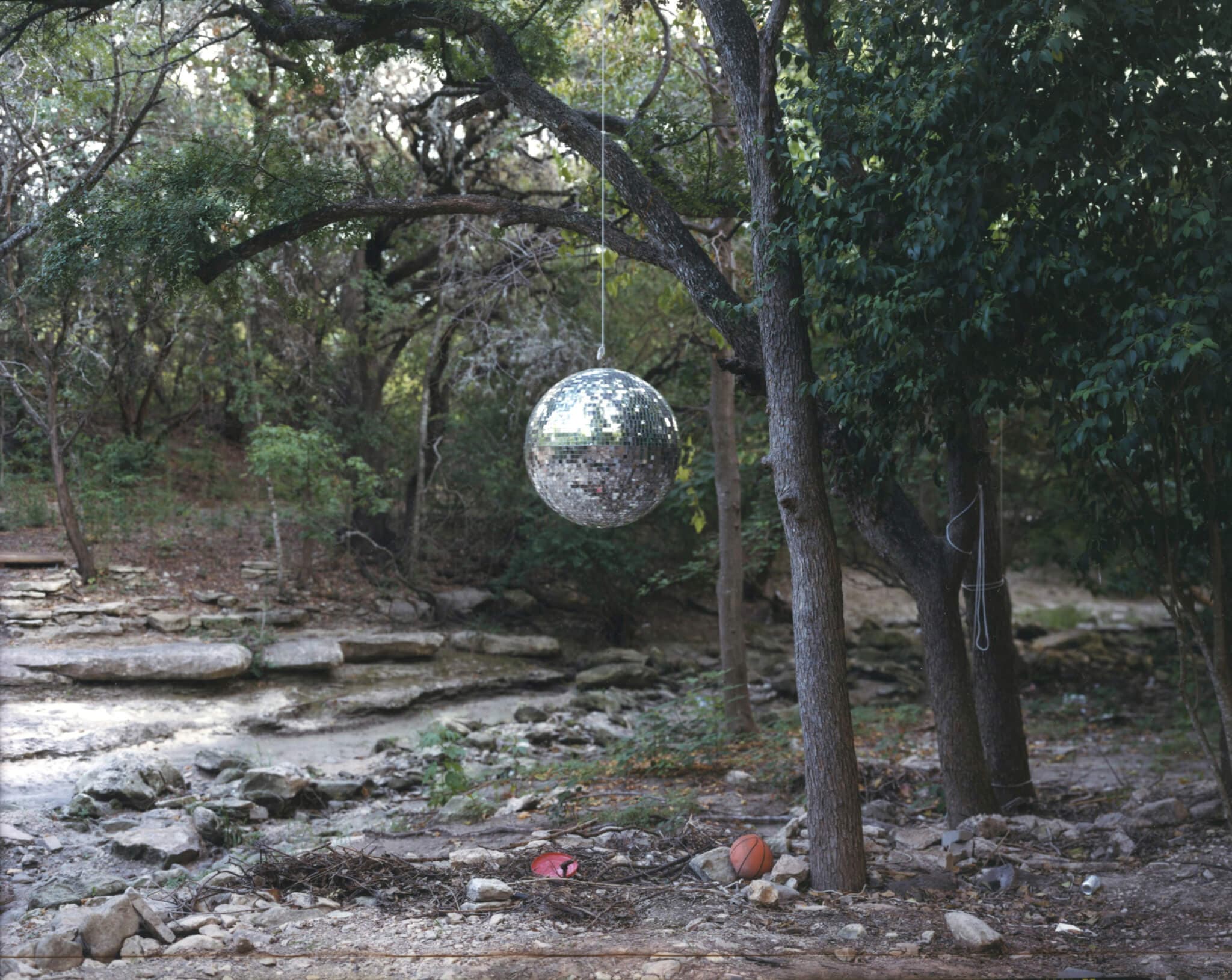
Alec Soth, Enchanted Forest (36), Texas, 2006. Pigmented inkjet print. High Museum of Art, Atlanta, commissioned with funds from Photo Forum and the Friends of Photography for the Picturing the South series, 2009.12. © Alec Soth / Magnum Photos.
“A Long Arc: Photography and the American South since 1845,” March 2–July 31, 2024
Addison Gallery of American Art
3 Chapel Ave., Andover
Embark through the tumultuous history of the American South with “A Long Arc: Photography and the American South since 1845.” Originally organized by the High Museum of Art in Atlanta, this is the first major survey of southern photography in twenty-five years. This comprehensive exhibition explores the complex relationship between photography and southern identity. Training a lens on pivotal moments such as the Civil War, the Great Depression, and the Civil Rights movement, the work documents the trauma and complexities that have shaped the region’s narrative, capturing economic shifts, racial disparities, and the ongoing pursuit for justice. “A Long Arc” promises to invite reflection and dialogue, asking visitors to reconsider what has defined the South’s cultural evolution over the past two centuries. —Kaitlyn Ovett Clark
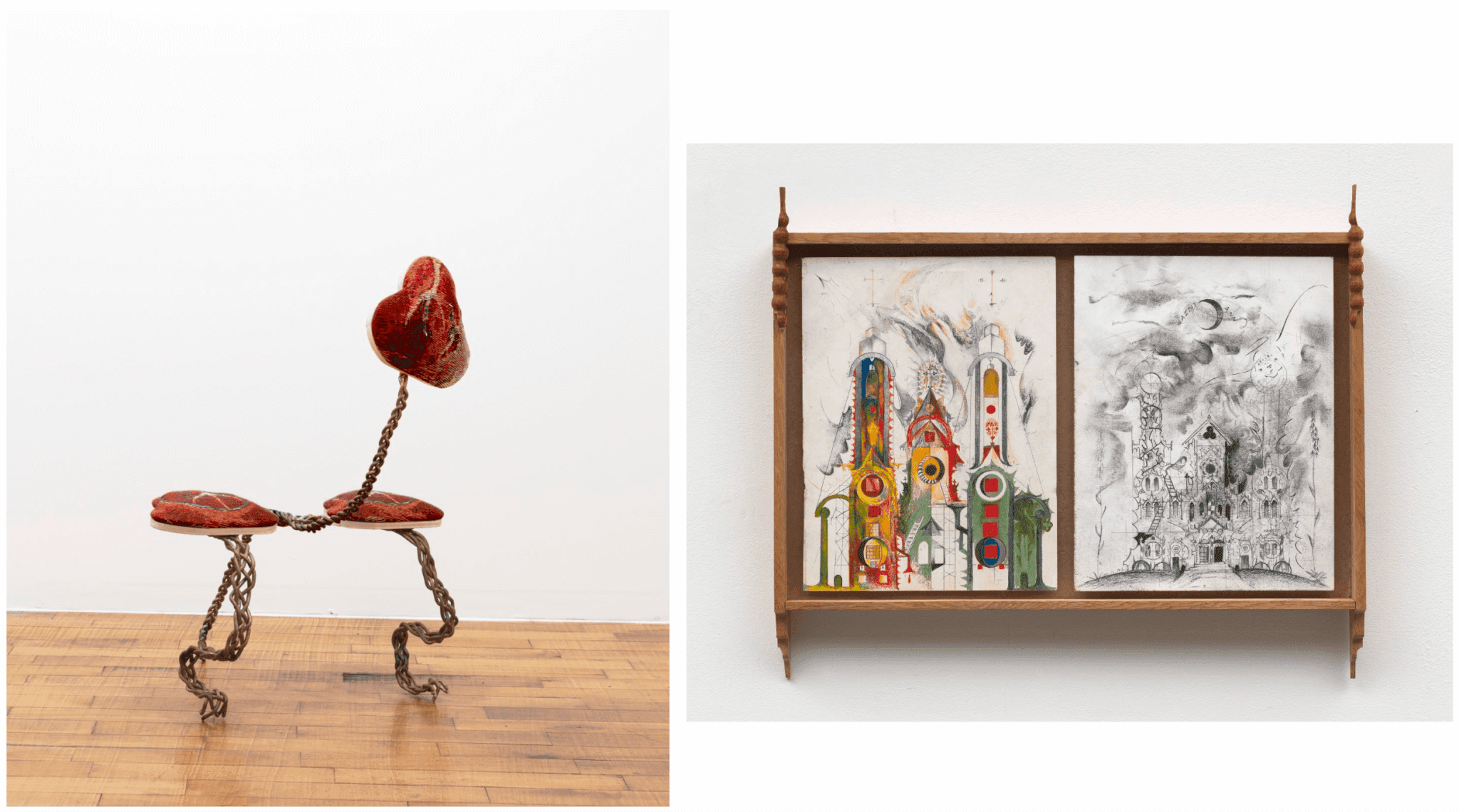
(left) Brittni Ann Harvey, Weeping Willow Angel (Robot Dog on Hind Legs), 2021. Polyester on jacquard-woven fabric, plywood, polyfill, bronze. 19 × 30 × 18 in. Courtesy the artist and Someday, New York. (right) Harry Gould Harvey IV, Presupposition of Saint Anne, 2023. Colored pencil, charcoal, xerox, white oak from Prudence Island. 19½ x 16 x 2¼ in. Courtesy the artist, KADIST Collection.
“List Projects 29: Brittni Ann Harvey and Harry Gould Harvey IV,” March 7–June 23, 2024
MIT List Visual Arts Center
20 Ames St., Cambridge
As the founders of the Fall River Museum of Contemporary Art, Brittni Ann Harvey and Harry Gould Harvey IV have sought to champion the work of South Coast artists. This spring, the List Center is putting the pair’s own art in the spotlight, and their personal practices are likewise grounded in a strong sense of place. Nodding to both the region’s history of textile manufacturing and the state’s growing robotics industry, Brittni Ann Harvey’s uncanny sculptures resemble military-ready robo-dogs—but these bots are upholstered in velvets and jacquards that could be pulled from altar cloths, and they feel both futuristic and antique, threatening and vulnerable. Meanwhile, Harry Gould Harvey IV makes devotional drawings framed with wood from his hometown’s fallen trees and sculptures evoking sacred architecture through materials salvaged from old Fall River factories and churches. Both artists bring explorations of the metaphysical down to earth—down to their particular post-industrial patch of earth—in surprising ways. —Jacqueline Houton
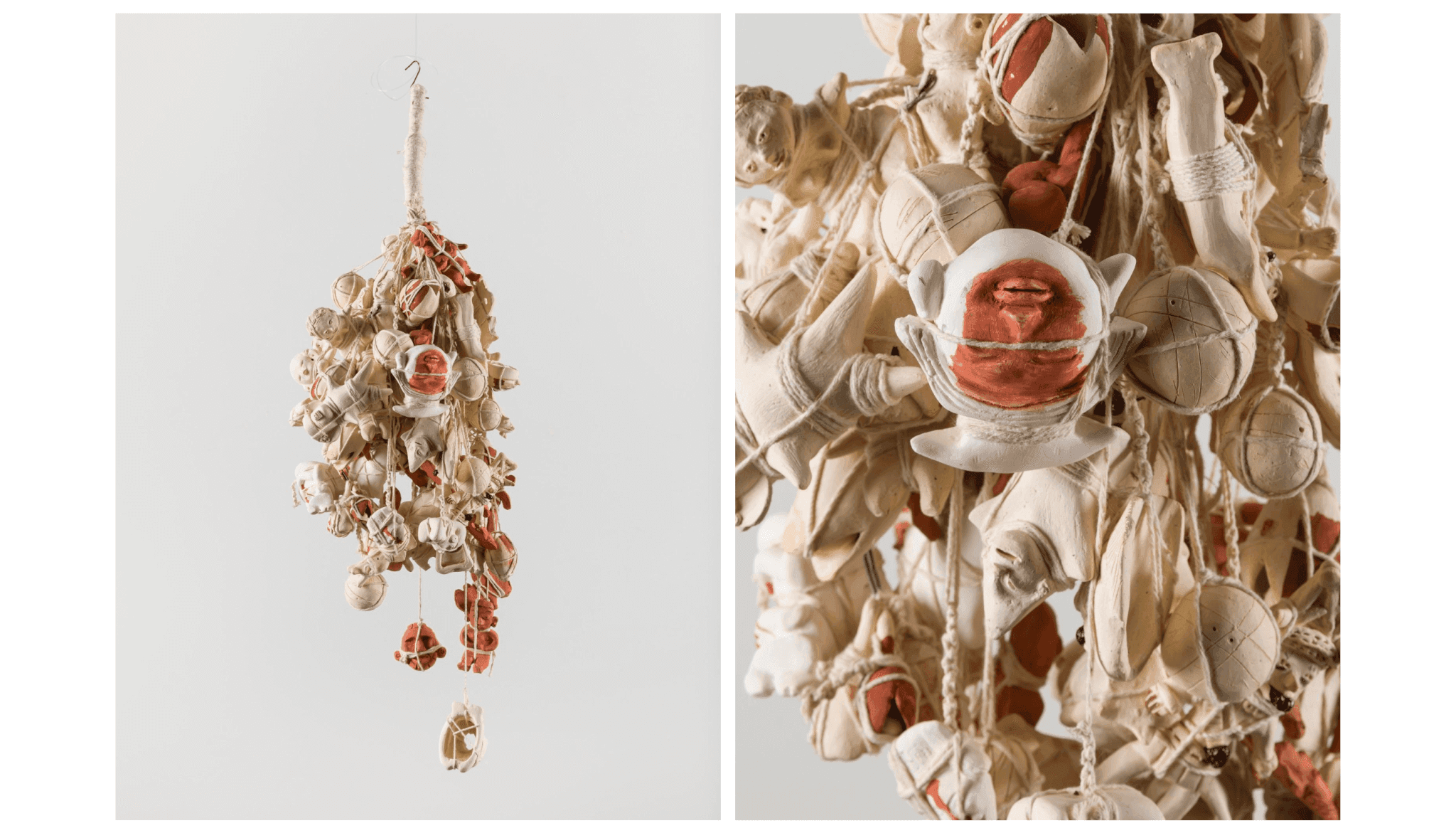
(left) Noé Martínez, Racimo 3, 2022. High-temperature ceramic and porcelain with oxide slip and cotton rope. 32″ x 8¼ ” x 8¼”. (right) Noé Martínez, Racimo 3 [detail], 2022. © Noé Martínez; Courtesy of the artist and Patron Gallery, Chicago, IL.
“Noé Martínez: The Body Remembers,” March 13–June 16, 2024
Rose Art Museum
415 South St., Waltham
Through disciplines such as epigenetics, researchers are finding scientific explanations for phenomena that many artists and healers have long understood: our bodies hold on to the stories of our ancestors. Opening on March 13 at the Rose Museum, Indigenous Mexican artist Noé Martínez’s show “The Body Remembers” will make use of a range of mediums to identify, extricate, and honor the complicated traumas inflicted on the Huastecan people throughout centuries of colonization, exploitation, and systematic silencing. With life-sized drawings enveloping the space, figurative vessels fashioned from clay in the pre-Hispanic style, and a video performance of a ceremonial dance, the show promises to both evoke and enact rituals of processing and healing, illuminating the hard truths held in our bodies and freeing them into a more hopeful future. —Jessica Shearer
Kaitlyn Ovett Clark is managing editor for Boston Art Review and the exhibitions manager at the Tufts University Art Galleries at the SMFA.
Karolina Hać is an editor at Boston Art Review and head of marketing at Höweler+Yoon Architecture, LLP.
Niara Simone Hightower is editorial assistant and Boston Art Writing Fellowship coordinator at Boston Art Review.
Jacqueline Houton is a senior editor at Boston Art Review and a copyeditor at Candlewick Press.
Jameson Johnson is editor-in-chief and executive director at Boston Art Review.
Gina Lindner is an arts administrator, curator, and contributor to Boston Art Review.
Jessica Shearer is a senior editor at Boston Art Review and director of communications and user experience at the Boston College Center for Corporate Citizenship.
Jacquinn Sinclair is an editor at Boston Art Review and a contributing performing arts writer and critic for WBUR’s ARTery.
BAR Editorial
Team Member
This article includes contributions from Jacqueline Houton, Jameson Johnson, Emmy Liu, Ava Mancing, Jessica Shearer, Jacquinn Sinclair, Alisa Prince, and Tori Wong.
More Info